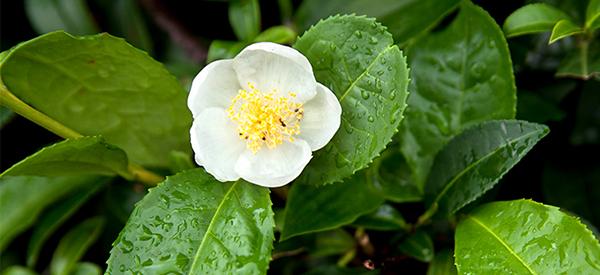
Tea Plant (Green Tea)
The Camellia is a popular garden plant in many countries. However, one species has comparatively modest flowers but a hidden, significant value: Camellia sinensis or the Chinese Camellia, Tea Plant, or Tea Shrub. The plant’s third name, Tea Tree, can lead to confusion as to the plant that tea tree oil is obtained from (Melaleuca alternifolia) is entirely different.
While these common names may seem a little broad, they are deserved because, astonishingly, all global commercial teas – other than herbal ones – are produced from just two varieties of this plant.
The way different teas are produced depends entirely on how the plant is processed and the resulting levels of oxidation of the leaves. As a result, the two variants of this camellia species are grown commercially on an extremely large scale.
But, for the purposes of this article, we will focus on one species, Camellia sinensis var. sinensis, and one of the teas it gives us: Green Tea.
The history of Green Tea
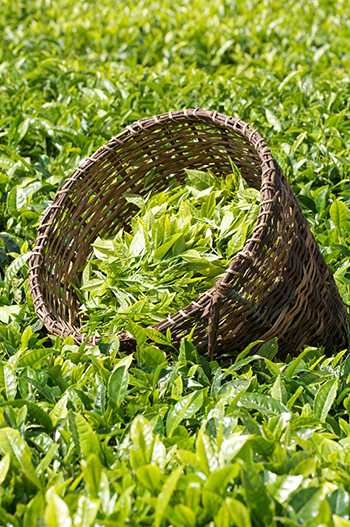 According to the International Institute of Sustainable Development, tea is the second most consumed beverage in the world. Green Tea specifically has been produced and consumed for many centuries and celebrated for its health-giving and healing properties.
According to the International Institute of Sustainable Development, tea is the second most consumed beverage in the world. Green Tea specifically has been produced and consumed for many centuries and celebrated for its health-giving and healing properties.
It is believed that Camellia sinensis seeds or plants were introduced into Korea in the 4th century and Japan in the 9th century by Chinese Buddhist monks. By 1185 the practice of tea drinking had been introduced to the Japanese royal family, and monks urged all people to drink Green Tea for its health benefits. Green Tea was used as an offering to Buddha and was the center of some Religious Ceremonies and Tea Ceremonies.
Green tea continues to enjoy popularity except that it is now global. This type of tea is currently the most widely produced one in China.
Where this plant is found
This species of camellia is native to three large regions: East Asia, Southeast Asia, and the Indian subcontinent. While most of the commercial growth remains in these locations, this plant is now cultivated for commercial and horticultural purposes across the globe. It is particularly successful in areas with tropical and subtropical climates.
Related: The Complete Map of Edible Plants: Find Out What You Have in Your Area! (Video)
How to identify Green Tea
When grown in plantations or gardens, it is grown as an evergreen shrub that is pruned to a height of 3 ¼ – 6 ½ feet or 1 – 2 meters. However, in the wild, this plant grows into a tree with a naturally bowl-shaped canopy and rough, grey bark. These camellias can reach 29 ½ feet / 9 meters.
 Leaf: The leaves are green, shiny, lanceolate, alternate, and have serrated edges. Young leaves are light green, and they darken as they mature. The undersides are slightly hairy.
Leaf: The leaves are green, shiny, lanceolate, alternate, and have serrated edges. Young leaves are light green, and they darken as they mature. The undersides are slightly hairy.
- Flower: The fragrant flowers are small (1 ½ inch – 4 centimeters in diameter) and white with a central cluster of bright yellow stamens. Blooms grow singly, not in clusters, and have 7 petals on average.
- Root: This plant has a strong taproot that sends out filament roots.
It is the flower that is the most useful way to differentiate this camellia from the myriad of species and cultivars available.
How to grow Camellia sinensis
To be honest, very few of us are likely to grow this plant at home specifically to make our own green tea. However, you could if you wanted to! In fact, you don’t even need a garden as this camellia is happy in a container so long as certain conditions are met.
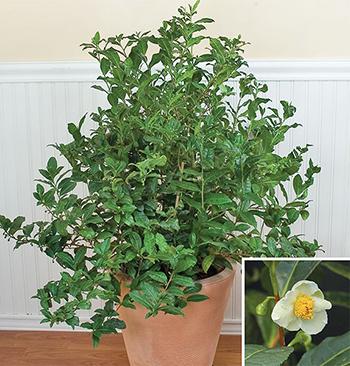
Tea Plants are hardy. However, if you live where winters get cold (below -100 Celsius / 140 Fahrenheit) you would need to plant the shrub in a container that you can bring indoors for the cold months. It is advisable to plant into a mixture of potting soil and sphagnum moss if you are using a container.
If you live in a region where you can plant outdoors, this camellia requires slightly acidic, sandy, and well-drained soil.
Don’t allow these plants to dry out completely and feed them with citrus or ericaceous feed after their first burst of growth of the season. You can prune this shrub so that it remains at a height of approximately 3 feet / 91 ½ centimeters. alternatively, you can let it find its natural shape and size as a large shrub or small tree.
Get Your Own Medicinal Seeds, Last 30 Packs Left
How to harvest this plant and process it for Green Tea
Growing Chinese Camelia for the purposes of making your own tea requires patience because the plant should be about 3 years old before you start harvesting leaves.
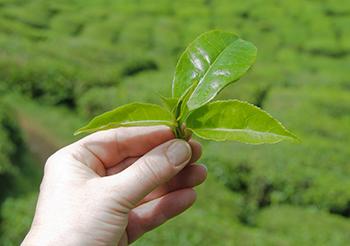
Both the leaves and flowers can be harvested and dried; the blooms enhance the flavor and aroma of teas.
How you harvest and process the plant is what determines the type of tea you obtain. These methods aim to maximize the amounts of polyphenols and volatile organic compounds that are retained as these determine taste and aroma.
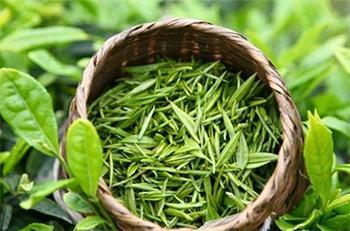
The top two young leaves and the leaf buds from the first new growth of spring yield the best quality in terms of active ingredients and taste.
The traditional and artisanal methods of Green Tea production are pan-firing, sun-drying, or basket or charcoal firing. Modern methods that are better suited to DIY tea makers are sun- or oven-drying, tumbling, or steaming.
What Green Tea is good for and the natural remedies made from it
The health benefits of Green Tea are attributed to multiple active ingredients, vitamins, and trace minerals:
- Antioxidants, specifically Epigallocatechin Gallate (EGCG)

- Caffeine
- Calcium
- Iron
- Magnesium
- Manganese
- Polyphenols
- Potassium
- Sodium
- Vitamins B-1, B-2, B-3, B-6, and C.
Because of these bioactive ingredients, Green Tea is thought to be effective in:
- Lowering the risk of clogged arteries
- Reducing cholesterol levels
- Lowering or increasing blood pressure slightly
- Treating acne when applied topically
- Reducing the risk of some cancers including bladder, breast, colon, rectal, and endometrial cancers
- Boosting memory
- Combatting anxiety
- Treating low-grade urinary tract infections
- Soothing sore throats (when used as a gargle)
- Decreasing severity and duration of the common cold and ‘flu
- Lowering the risk of kidney stones
- Improving mental alertness
- Reducing the risk of gum infection (when the leaves are chewed or in gel form)
- Easing dental pain (when used as a mouthwash)
- Boosting metabolism and thereby aiding weight loss.
This is an impressive list of possible health benefits. It must, however, be kept in mind that although there is anecdotal evidence to support some of these claims, there is little or no clinical evidence.
Related: Just Like Xanax, The Anxiety Relieving Plant That Grows In Your Backyard (Video)
What parts of the plant are used in remedies?
The leaves and flowers are used to produce teas, and seeds are used to produce oils. The leaves are also used to manufacture extracts, powder, and ointments.
A DIY Green Tea recipe
If you have a Tea Plant there are several steps you can follow to produce your own green tea, beginning with picking the youngest leaves and leaf buds.
Then:
• Steam them for 1 – 2 minutes (as you would steam vegetables) until they become soft and turn olive green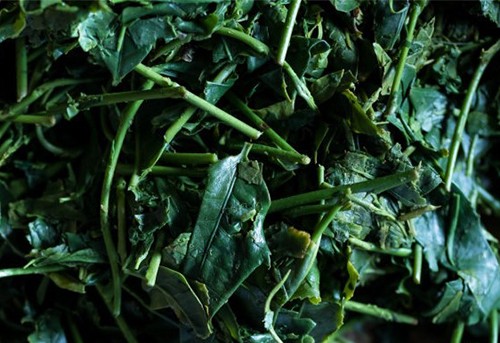
• Gently rinse the leaves under cold water. This stops the oxidization process.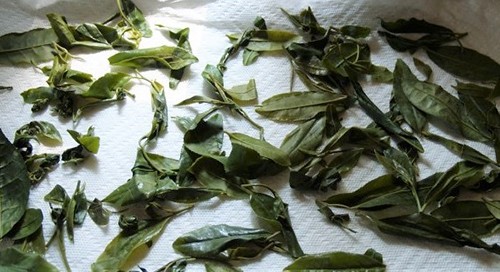
• Carefully place the leaves up and lay them on a baking sheet
• Place the tray in an oven set at 230 Fahrenheit / 110 Celsius for 10 – 12 minutes. The leaves should turn dark green and feel crisp to the touch.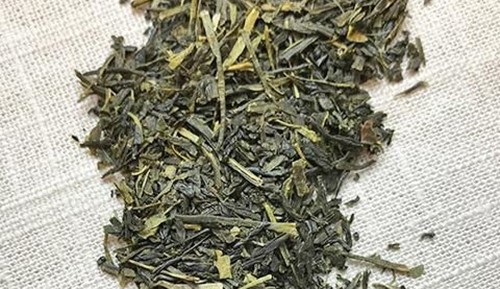
• Store the dried leaves in an airtight container in a cool, dark, dry place.
You can also include washed and thoroughly dried flowers in the storage container with the dried leaves as they enhance flavor and aroma. Of course, your other option is to buy Green Tea commercially in tea bags or loose.
To make the tea:
- Place 5 – 6 leaves in a teapot (traditionally a clay or porcelain pot). You could also place the leaves into a tea bag or holder and then into the pot. If you are using loose tea rather than whole leaves, use 1 teaspoon per cup
- Boil recently boiled, not boiling, filtered water gently over the tea
- Swirl the water slowly around the pot for 5 seconds to allow aeration
- Leave the tea to steep or draw for 1 to 3 minutes depending on the strength of flavor you enjoy
- If you use loose leaves (rather than a bag), pour the tea through a sieve into a cup.
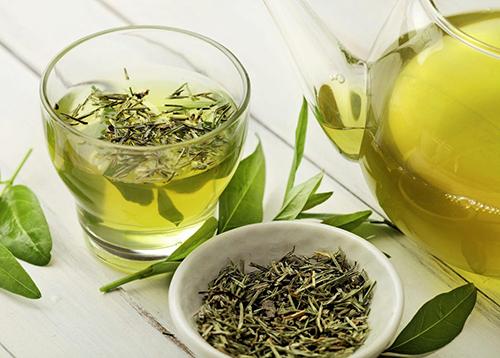
Sip the tea when it is still warm. Don’t add milk or sweetener of any kind as they will destroy the flavor and aroma.
Related: 1 Cup Before Bed Shrinks Belly Fat All Night (Video)
Dosage
While there have been a limited number of clinical studies involving Camellia sinensis, not all the findings are conclusive. Secondly, some studies examined similar forms of the plant and or conditions but produced findings that contradict each other.
As a result, it is strongly suggested that you only include Green Tea / Chinese Camellia in your wellness program if you are under medical care, taking any medication, or are concerned in any way.
What plants resemble Green Tea?
There are a dizzying number of camellia species and cultivars available. If you specifically want a Camellia sinensis, purchase your shrub from a reputable retailer that labels plants accurately.
There is a plant that is related to the camellia family and may cause a little confusion.
| Feature | Tea Plant / Tea Shrub / Chinese Camellia Camellia sinensis | Mountain Stewartia / Summer Dogwood Stewartia ovata |
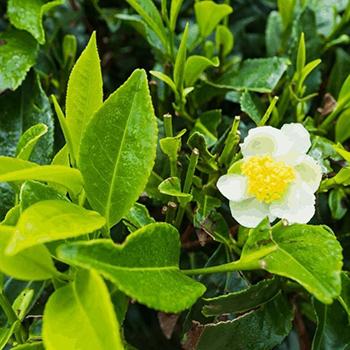 |
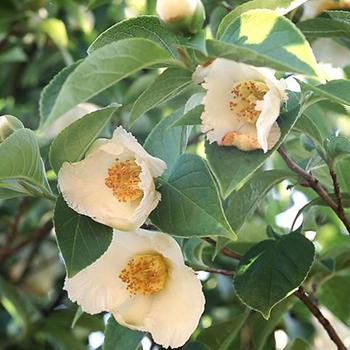 |
|
| Size | Can grow up to 29 ½ feet / 9 meters in height if unpruned | Can grow up to 16 feet / 5 meters in height if unpruned |
| Leaves | Bright green, shiny, lanceolate leaves with serrated edges that darken with age; undersides are slightly hairy | Dark green oval leaves with pointed tip; turn orange, red, or gold in the fall |
| Flowers | Fragrant, small, white flowers with a central cluster of bright yellow stamens; blooms grow singly, not in clusters; 7 petals | Flowers are white and camellia-like but larger than those of sinensis; five petals; numerous white, yellow, or purple stamens |
| Bark | Rough and grey | Flaky and grayish orange |
| Edible / Medicinal | A range of teas produced | Young leaves cooked as vegetable |
If you consume the leaves of Stewartia ovata you are unlikely to suffer any ill effects (unless you experience an allergic reaction). However, the resulting tea won’t offer the enjoyment or benefits that Green Tea from Camellia sinensis does.
Warning And cautions
There are some listed potential adverse reactions to Green Tea consumption if it was consumed in excess (more than 6 cups per day). They include:
- gastric upset
- insomnia
- irritability
- dizziness
- raised blood pressure
- liver toxicity and kidney damage in extreme and rare cases.
Several of these side effects can be attributed to caffeine content. This ingredient is also the main reason why pregnant and breastfeeding women are advised not to drink more than a few cups a day.
Individuals suffering from IBS, liver or kidney disease, anemia, anxiety, bleeding disorders, heart conditions, diabetes, diarrhea, seizures, glaucoma, or weak bones would be advised to avoid Green Tea unless their health practitioner has indicated it is safe to drink it.
Finally, Green Tea can interact with certain medications and substances including but not limited to birth control drugs, stimulants, blood thinners, certain antibiotics, diabetes medications, some antacids, alcohol, and certain antidepressants.
The bottom line is that, even with plant-based substances or an apparently innocuous substance such as tea, it is strongly advised that you check with your healthcare provider if you are suffering from a medical condition and/or taking medication before you start drinking Green Tea. And remember, even with the nod from your practitioner, drink fewer than 6 cups a day.
You may also like:
 The 6 Best Bedtime Teas To Help You Sleep
The 6 Best Bedtime Teas To Help You Sleep
Ancient Japanese Tonic Melts 54lbs Of Fat (Video)
Soak Your Troubles Away with Homemade Tub Tea

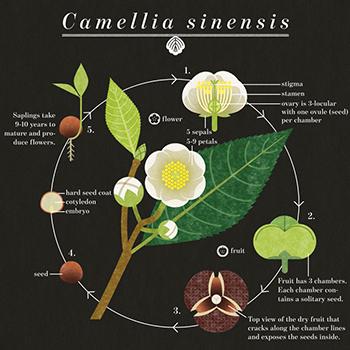 Leaf: The leaves are green, shiny, lanceolate, alternate, and have serrated edges. Young leaves are light green, and they darken as they mature. The undersides are slightly hairy.
Leaf: The leaves are green, shiny, lanceolate, alternate, and have serrated edges. Young leaves are light green, and they darken as they mature. The undersides are slightly hairy.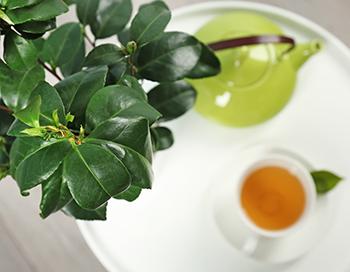
For camellia sinensis, you listed the growing temp as -100C/ 140 Fahrenheit. This is incorrect, as 140 F would be blistering hot anywhere! Better check your sources. Tea is being grown in the US, within growing zones that fall well below 140!
Hi Lynn,
Thank you so much for your comment.
We apologize for this. It was a formatting error. It should be below -10 Celsius / 14 Fahrenheit.
Thank you for your understanding and support.
God bless!
Please check and correct your temperatures for max cold toleration. I think what you mean is -10*c and 14*f
Hi Kathlena,
Thank you so much for your comment.
We apologize for this. It was a formatting error. It should be below -10 Celsius / 14 Fahrenheit.
Thank you for your understanding and support.
God bless!
Wonderful article about a wonderful tea. It makes me wonder if I could grow it where I live. Thank you for posting.
It was listed something about teabags reduced something in the tea but I didn’t see where that info was. It was in the main page in the email for green tea.
Hi Mary,
The information was available only in the mail, as an introduction to this article.
Teabags are usually made from low tea grades, such as dust and fannings. Freshness can also be a major issue with typical teabags for this reason, especially if they are packed in a paper box with paper wrapping.
When you steep loose-leaf tea, it has room for tea leaves to absorb water and expand as they infuse. This allows the water to flow through the leaves and extract a wide range of vitamins, minerals, flavors, and aromas from the leaves. When you steep tea in a teabag, its infusion is limited by the size of the teabag.
I hope this helps 🙂
God bless!
Good question Mary. I had wondered this, too. LH: Good to know about the water flowing in a tea bag. I’ve often wanted to poke a hole in my Bigelow green tea bag. I dunk and dunk hoping that’s good enough. Glad to know it’s not something in the actual teabags themselves. Thank you for posting and God Bless you, too.
Yeah, Mary… l wondered the same thing. How can they leave the entire teabag idea out?!?
I like your work.
Please keep doing it.
Thank you ❤️👍
Hi Andrew,
Thank you for your feedback.
We really appreciate it!
Perhaps an error: As a result, it is strongly suggested that you only include Green Tea / Chinese Camellia in your wellness program if you are under medical care, taking any medication, or are concerned in any way.
There is a tea plantation outside Charleston, South Carolina! Tours are available…. The original plants are over 100 years old! Charleston Tea Plantation
Thank you for sharing Beth. I think I found the Charleston Tea Garden. Is that the site? I look forward to looking at their products as I drink green tea often. I did not know it was grown in the USA.
There is a tea plantation in Brookhaven , Mississippi as well
This is a very interesting read. Loved the points you make. Am sharing your blog for further circulation.